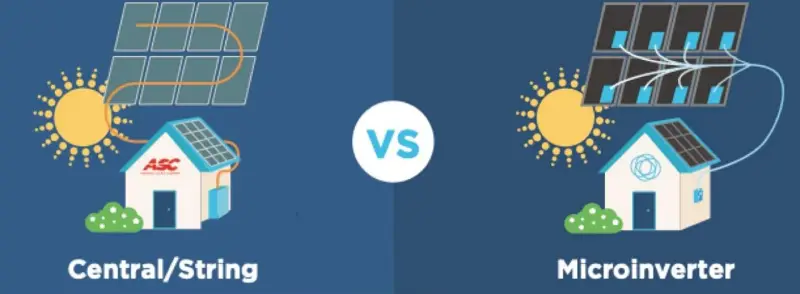When you go solar, your system’s job is to take power from the sun and convert it into electricity for your home. But to do that, your panels need something called an inverter—a device that changes DC (direct current) power from the panels into AC (alternating current) power, which is what your home uses.
Now here’s the important part: not all inverters are created equal.
There are two types of inverters used in most solar systems today: string inverters and microinverters. At Momentum Solar, we only use microinverters, because they’re more efficient, safer, and deliver a better long-term value than string inverters used by other companies.

What’s the Difference?
⚡ String Inverters (Central Inverters)
- All panels are connected in a “string” (like Christmas lights).
- The combined DC power from all the panels is sent to one large inverter, usually mounted on the side of your house.
- The inverter converts the power to AC for your home.
⚡ Microinverters
- Each panel has its own small inverter installed underneath it.
- The DC power is converted to AC power right at the panel.
- The energy flows directly to your home as usable power.
Performance: Panel Independence vs. Shared Limits
With string inverters, your entire system’s performance depends on the weakest panel. If just one panel is shaded by a tree or cloud—or gets dirty—the whole string’s performance drops. It’s like the old Christmas lights: if one bulb goes out, the whole strand gets dim.
Microinverters solve that problem. Because each panel operates independently, one underperforming panel doesn’t affect the rest. You’ll get maximum production from every panel, all the time, which means more savings and a better return on your investment.
Safety: High Voltage vs. Low Voltage
String inverter systems use high-voltage DC wiring, which means electricity travels across your roof and down to the inverter before being converted to AC. That creates safety concerns, especially if something goes wrong, like a short or malfunction. High-voltage systems also require manual shut-off in case of emergencies.
Microinverters are much safer. Since each panel converts its power to AC right on the roof, there’s no high-voltage DC running through your system. If there’s ever a problem, the system will automatically shut off, reducing the risk of overheating or fire.
Aesthetics: Clean and Unnoticeable
A string inverter system often requires large, boxy inverters (about the size of a kitchen cabinet) to be mounted on the side of your home. If you need more than one, it can look bulky and unattractive.
Microinverters are small, low-profile devices that are mounted underneath the panels, hidden from view. The result? A clean, modern solar setup that complements the look of your home.
Maintenance and Monitoring
With string inverters, if one panel stops working or drops in performance, you usually won’t know until you notice a higher electric bill. At that point, you’ll need a tech to inspect the whole system to find the problem—costing you time and missed savings.
Microinverters offer panel-level monitoring. You can see exactly how each panel is performing through your mobile app. If one panel has an issue, you’ll know right away and can quickly get it fixed—before it costs you money. (Monitoring availability may vary if financing through a loan.)
Warranty & Long-Term Value
String inverters typically come with a 10 to 12-year warranty—but solar systems often last 25 years or more. That means you’ll likely have to replace your inverter halfway through the life of the system, which is an added expense most homeowners don’t expect.
Momentum’s microinverters come with a 25-year warranty, just like your panels. That means your entire system is covered, giving you peace of mind and long-term performance without the worry of replacement costs.
Why Some Companies Use String Inverters
Some companies still use string inverters because they’re cheaper up front. But cheaper doesn’t always mean better. You may save a little at the start—but you’ll lose more over time with reduced performance, added risk, and unexpected replacement costs.
At Momentum, we focus on long-term value. That’s why we only use microinverters—so you can enjoy more savings, better performance, and a safer, smarter system.
Final Thoughts: The Clear Choice
When it comes to your solar investment, the choice is clear:
| Feature | String Inverter | Microinverter (Momentum) |
|---|---|---|
| Panel Independence | ❌ No | ✅ Yes |
| Safety Level | ⚠️ High Voltage | ✅ Low Voltage |
| Aesthetics | ❌ Bulky Boxes | ✅ Hidden Under Panels |
| Monitoring | ❌ Limited | ✅ Panel-Level |
| Warranty | 🔁 10–12 Years | ✅ 25 Years |
| Long-Term Value | ❌ Less | ✅ More |
Ready to Go Solar with Confidence?
I’m Frank, your trusted Momentum Solar consultant here in Southwest Florida. I’m here to help you get the best system for your home—with microinverters that deliver more power, more savings, and more peace of mind.
Let’s schedule your free solar consultation and see how easy it is to get started with a better system—with no money out of pocket and built to last.
